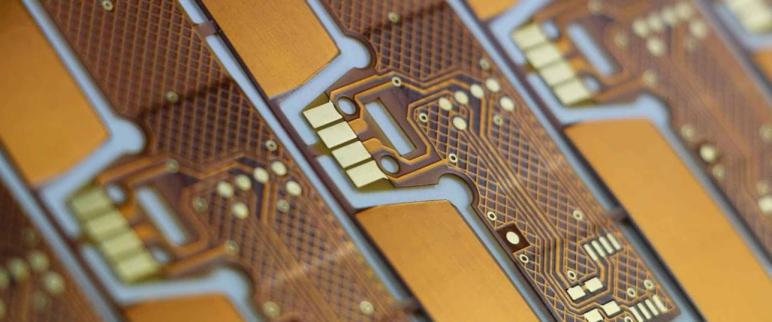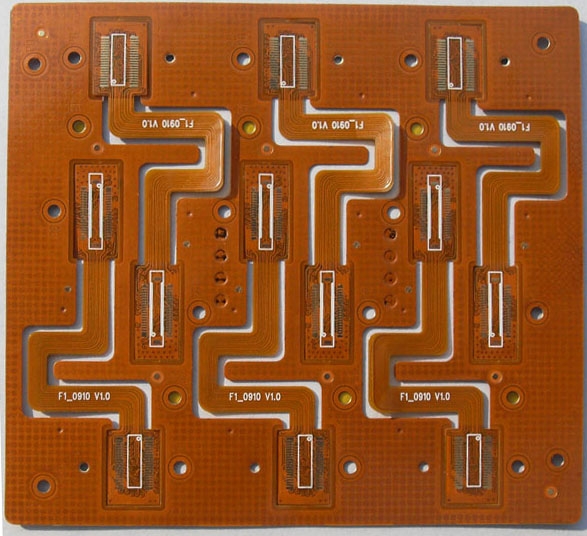Flexible Printed Circuit Boards, commonly referred to as flex PCBs or FPCBs, represent a category of electronic circuit boards designed to maintain full functionality even when subjected to bending, twisting, or folding. These boards are primarily composed of a flexible substrate material, typically crafted from polyimide or polyester, and feature conductive traces intricately etched onto their surfaces. These conductive traces serve as the vital pathways for interconnecting electronic components, rendering flexible PCBs an indispensable component in a wide array of electronic devices.

In contemporary electronics, Fast Turn Flexible PCB holds significant importance due to its adaptability and capacity to enable innovative design possibilities. In this fast-paced industry, the ability to achieve rapid turnaround times is of paramount significance. This expeditious production and delivery are essential to meet the ever-evolving demands of the market, curtail development expenses, and secure a competitive advantage. Consequently, manufacturers and designers must place a premium on operational efficiency and swiftness in the production and supply chain of flexible PCBs to maintain their leadership in the dynamic landscape of the electronics sector.
Advantages of Flexible PCBs
Flexible Printed Circuit Boards, commonly referred to as Flexible PCBs or FPCBs, bring forth a multitude of advantages that position them as the favored choice across diverse electronic applications. Below, we outline these key advantages:
Compact Size with High Density
Flexible PCBs excel in accommodating a high density of components and intricate circuitry within a compact form factor. This feature empowers designers to craft smaller and lighter electronic devices while preserving essential functionality.
Adaptive and Lightweight Designs
FPCBs, owing to their flexibility and slender profile, prove ideal for applications where weight and spatial constraints are pivotal. They can be bent, folded, or contoured to seamlessly fit into constrained spaces or conform to unconventional design requirements, thereby fostering innovation and space-efficient solutions.
Enhanced Heat Dissipation
Flexible PCBs can be ingeniously designed with integrated heat dissipation mechanisms, including thermal vias and metal core substrates. These features enhance the efficient dispersal of heat generated by electronic components, mitigating the risk of overheating and bolstering the overall reliability of the device.
Resilience in Hostile Environments
FPCBs are renowned for their robustness and resilience against adverse environmental conditions. They exhibit the ability to endure exposure to moisture, chemicals, dust, and extreme temperature fluctuations far more effectively than traditional rigid PCBs. This quality renders them well-suited for deployment in demanding and challenging environments.
Vibration Resistance
Flexible PCBs exhibit a notable resistance to mechanical stress and the detrimental effects of vibrations, a facet where rigid boards may falter. This resilience to vibration safeguards the integrity of electrical connections and diminishes the likelihood of solder joint failures, particularly crucial in applications subjected to movement and mechanical stresses.
The Significance of Speed in PCB Manufacturing
Speed is an indispensable factor in the realm of Fast Turn Flexible PCB manufacturing, influencing various facets of the industry. Let's delve into the pivotal role that speed plays in the manufacturing of PCBs:

Meeting Strict Product Launch Deadlines
In the dynamic electronics sector, the expeditious introduction of new products is imperative. PCBs form the core of most electronic devices, and any delays in their production can disrupt the entire product development schedule. Speedy manufacturing ensures that PCBs are available when needed, enabling companies to adhere to their product launch schedules and gain a competitive edge.
Outpacing Competitors in Product Introduction
The electronics market is intensely competitive, and being the first to introduce a novel product can be a game-changing advantage. Swift PCB manufacturing empowers companies to launch their products ahead of competitors, capturing an early market share and establishing themselves as leaders in the industry.
Responding to Unanticipated Demand Surges
Electronics demand often exhibits unpredictability. The ability to rapidly scale up production to address unforeseen spikes in demand is crucial. Whether triggered by an unexpected trend or unforeseen circumstances, the capability to manufacture PCBs promptly ensures that companies can capitalize on market opportunities without compromising quality.
Efficient Handling of Revisions and Design Changes
Product development is an iterative process, and modifications to designs are commonplace. Speedy PCB manufacturing allows for the swift integration of design revisions and updates. This agility diminishes the time and cost associated with design changes, ensuring that products can adapt swiftly to evolving requirements.
Minimization of Production Downtime
Delays in PCB manufacturing can lead to downtime across entire product lines. Expedited manufacturing processes help in minimizing such downtime, guaranteeing that production lines remain operational and efficient.
Reduction in Inventory Costs
Maintaining substantial PCB inventories can be financially burdensome. Speedy manufacturing enables companies to embrace a just-in-time approach, producing PCBs as needed. This approach reduces inventory holding costs and mitigates the risk of obsolete components.
Strategies for Achieving Swift Turnaround in PCB Manufacturing
Achieving rapid turnaround in Printed Circuit Board (PCB) manufacturing requires the implementation of efficient strategies and technologies. Here are key techniques to expedite the process:
Utilizing Advanced Design Software
Employing advanced PCB design software with optimization capabilities is paramount. These tools enable engineers to create efficient and error-free PCB layouts, reducing the need for design iterations. Optimized designs streamline the manufacturing process, saving valuable time.
Automation in Material Handling and Assembly
Automation plays a pivotal role in accelerating PCB manufacturing. Automated material handling systems and assembly processes reduce manual labor and human error. Robotics and automated pick-and-place machines can significantly enhance the speed and precision of component placement on PCBs.
Enhanced Inspection Technologies
Implementing advanced inspection technologies, such as automated optical inspection (AOI) and X-ray inspection, enables quicker and more accurate quality checks. These systems can rapidly identify defects and discrepancies, allowing for immediate corrections and preventing delays further down the production line.
Streamlined Communication Between Teams
Effective communication between design and manufacturing teams is essential. Collaboration tools and software platforms that facilitate real-time sharing of design files, feedback, and revisions can greatly streamline the process. This ensures that any design changes or clarifications are addressed promptly, minimizing delays.
By embracing these techniques and leveraging cutting-edge technologies, PCB manufacturers can achieve swift turnaround times, reduce production bottlenecks, and enhance overall efficiency in the production process. This, in turn, enables them to meet the demands of a fast-paced industry and deliver high-quality PCBs to their customers on time.
Risk Mitigation Strategies in PCB Manufacturing
Mitigating risks is a crucial aspect of Printed Circuit Board (PCB) manufacturing. Here are strategies to minimize potential disruptions and challenges:
Investing in Continuous Training for Staff
Ensuring that your workforce is well-trained and up-to-date with the latest industry practices is essential. Regular training programs can enhance skills, promote safety, and improve overall efficiency. Well-trained staff are better equipped to handle unexpected issues and maintain high-quality production.
Regular Maintenance and Updates of Manufacturing Equipment
Preventive maintenance is key to avoiding equipment breakdowns and production delays. Implementing a routine maintenance schedule for manufacturing equipment ensures that machines operate smoothly and minimizes the risk of unexpected downtime. Additionally, keeping equipment up to date with the latest technology can improve reliability and efficiency.
Incorporating Redundancy and Buffer Times
Building redundancy into critical processes and including buffer times in the production cycle can provide a safety net against unforeseen disruptions. Redundant equipment or backup systems can be activated quickly in case of failures, while buffer times allow for adjustments to accommodate unexpected delays without affecting overall production timelines.
Collaborating with Experienced Design and Prototyping Partners
Establishing partnerships with experienced design and prototyping firms can help mitigate risks related to design complexities and iterations. These partners can offer valuable insights, optimize designs, and reduce the likelihood of design-related issues during manufacturing. Prototyping services allow for thorough testing and validation before full-scale production, reducing the risk of costly errors.
By implementing these strategies, PCB manufacturers can proactively manage risks, enhance their operational resilience, and maintain a consistent level of production quality. These measures not only help mitigate disruptions but also contribute to long-term sustainability and success in the industry.
CONCLUSION
In the fast-paced world of electronics manufacturing, the ability to achieve rapid turnaround times for Fast Turn Flexible PCB is paramount. Meeting product launch timelines, outpacing competitors, addressing unexpected demand surges, and efficiently managing design revisions all hinge on the speed and efficiency of the manufacturing process.
In conclusion, the fusion of rapid turnaround strategies and risk mitigation measures in Flexible PCB manufacturing ensures that companies can consistently deliver high-quality products on time, meeting the timely needs of customers and keeping pace with the dynamic and competitive electronics industry. The ability to meet these needs not only fosters success but also builds lasting relationships with customers who rely on the speed, quality, and reliability of Flexible PCBs in their electronic innovations.










 2023-10-10
2023-10-10
 BEST
BEST

.png)
.png)
.png)
.png)

.png)

